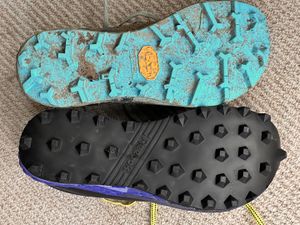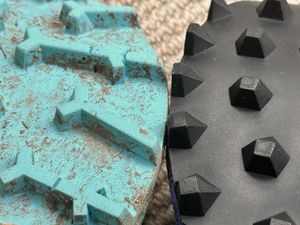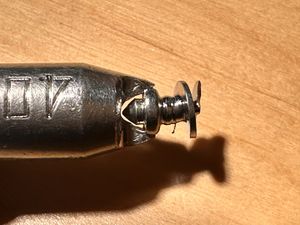Difference between revisions of "Frankenshoes"
User:Fellrnr (User talk:Fellrnr | contribs) (Created page with "A Frankenshoe is where the outsole of a shoe has been replaced, creating a shoe with better characteristics. This is different to where the outsole has been replaced simply to...") |
User:Fellrnr (User talk:Fellrnr | contribs) |
||
| Line 5: | Line 5: | ||
The two big downsides are cost and weight. Having a shoe resoled in the UK costs between £40 and £65 ($60 and $100, early 2024 prices). I think this is well worth the cost, as it produces a shoe that I couldn't have any other way but is still rather painful. The new sole will typically add weight, but how much depends on the weights of the old and new outsoles. The resoling involves sanding down the old outsole to form a flat surface to glue the new outsole to. I measured the Reebok outsole as adding about 50g to each shoe, and the Vibram Peak District outsole as adding about 25g to each shoe. That's very roughly about 15% for the Reebok and 7% for the Vibram. It's enough to notice, but not prohibitive for me. | The two big downsides are cost and weight. Having a shoe resoled in the UK costs between £40 and £65 ($60 and $100, early 2024 prices). I think this is well worth the cost, as it produces a shoe that I couldn't have any other way but is still rather painful. The new sole will typically add weight, but how much depends on the weights of the old and new outsoles. The resoling involves sanding down the old outsole to form a flat surface to glue the new outsole to. I measured the Reebok outsole as adding about 50g to each shoe, and the Vibram Peak District outsole as adding about 25g to each shoe. That's very roughly about 15% for the Reebok and 7% for the Vibram. It's enough to notice, but not prohibitive for me. | ||
=Which Outsole and Cobbler?= | =Which Outsole and Cobbler?= | ||
| − | I've tried two outsoles from two different cobblers, and I've been very happy with the quality of the work in both cases. | + | I've tried two outsoles from two different cobblers, and I've been very happy with the quality of the work in both cases. Both do mail order service in the UK. |
<gallery widths=300px heights=300px class="center"> | <gallery widths=300px heights=300px class="center"> | ||
Frankenshoes compare.jpeg|The Vibram Peak District (top) and Reebok Studs (bottom) | Frankenshoes compare.jpeg|The Vibram Peak District (top) and Reebok Studs (bottom) | ||
| Line 11: | Line 11: | ||
</gallery> | </gallery> | ||
==Cheshire Shoe Repairs and Reebok Studs== | ==Cheshire Shoe Repairs and Reebok Studs== | ||
| − | Cheshire Shoe Repairs provide a variety of outsoles, and I've used their "Pyramid Cross Country", which is labelled as Reebok on the outsole. It's a 8mm stud, and provides good grip on most surfaces. It's good on soft mud and most rocks, though it fails on some slick rock. It's surprisingly okay on concrete or asphalt, but that's not its forte. You can add metal spikes for winter running (see below), though it's awkward to get the spikes into the studs. The studs don't last as long as the rest of the shoe, and as the studs round off, the traction is reduced more than you might expect. | + | Cheshire Shoe Repairs provide a variety of outsoles, and I've used their "Pyramid Cross Country", which is labelled as Reebok on the outsole. It's a 8mm stud, and provides good grip on most surfaces. It's good on soft mud and most rocks, though it fails on some slick rock. It's surprisingly okay on concrete or asphalt, but that's not its forte. You can add metal spikes for winter running (see below), though it's awkward to get the spikes into the studs. The studs don't last as long as the rest of the shoe, and as the studs round off, the traction is reduced more than you might expect. https://www.cheshireshoe.co.uk/running-shoes-resoles-repairs/ |
==The Key Cobbler Kendal and Vibram Peak District== | ==The Key Cobbler Kendal and Vibram Peak District== | ||
| − | The Peak District outsole has 8mm lugs in a dog bone pattern. I've found this outsole to be as good or better than the Reebok outsole on all surfaces and seems to be much harder wearing. There are some slick rocks where it doesn't grip, but that's rare. The main downside is that you can't get metal spikes into this outsole as the lugs are too narrow. (Another downside is the cost, but prices have increased over the last few years | + | The Peak District outsole has 8mm lugs in a dog bone pattern. I've found this outsole to be as good or better than the Reebok outsole on all surfaces and seems to be much harder wearing. There are some slick rocks where it doesn't grip, but that's rare. The main downside is that you can't get metal spikes into this outsole as the lugs are too narrow. (Another downside is the cost compared with the Reebok, but prices have increased over the last few years for both.) https://keycobbler.co.uk/collections/running-shoe-repairs |
==Vibram Zegalite and Vibram Zegama== | ==Vibram Zegalite and Vibram Zegama== | ||
I've not tried either of these outsoles, as the Zegalite is only 4.5mm and the Zegama is only 4mm, which isn't much different to a standard trail running shoe. | I've not tried either of these outsoles, as the Zegalite is only 4.5mm and the Zegama is only 4mm, which isn't much different to a standard trail running shoe. | ||
Revision as of 04:32, 12 January 2024
A Frankenshoe is where the outsole of a shoe has been replaced, creating a shoe with better characteristics. This is different to where the outsole has been replaced simply to extend the life of a shoe. The goal with a Frankenshoe is to create an entirely new shoe, and often the outsole is replaced on a new shoe before any wear. This is typically done to put a more aggressive trail outsole onto a shoe that lacks traction. This can even be putting a trail outsole onto a road shoe.
Contents
1 Advantages of the Frankenshoe
The advantage of a Frankenshoe is the ability to have a shoe you like with an outsole that suits the terrain. For instance, I love Altra shoes, but they don't make a trail shoe with large studs for running on steep, soft ground. Another advantage can be that the replacement outsole is stiffer than the original, which provides more protection from rocks and stones.
2 The downsides of the Frankenshoe
The two big downsides are cost and weight. Having a shoe resoled in the UK costs between £40 and £65 ($60 and $100, early 2024 prices). I think this is well worth the cost, as it produces a shoe that I couldn't have any other way but is still rather painful. The new sole will typically add weight, but how much depends on the weights of the old and new outsoles. The resoling involves sanding down the old outsole to form a flat surface to glue the new outsole to. I measured the Reebok outsole as adding about 50g to each shoe, and the Vibram Peak District outsole as adding about 25g to each shoe. That's very roughly about 15% for the Reebok and 7% for the Vibram. It's enough to notice, but not prohibitive for me.
3 Which Outsole and Cobbler?
I've tried two outsoles from two different cobblers, and I've been very happy with the quality of the work in both cases. Both do mail order service in the UK.
3.1 Cheshire Shoe Repairs and Reebok Studs
Cheshire Shoe Repairs provide a variety of outsoles, and I've used their "Pyramid Cross Country", which is labelled as Reebok on the outsole. It's a 8mm stud, and provides good grip on most surfaces. It's good on soft mud and most rocks, though it fails on some slick rock. It's surprisingly okay on concrete or asphalt, but that's not its forte. You can add metal spikes for winter running (see below), though it's awkward to get the spikes into the studs. The studs don't last as long as the rest of the shoe, and as the studs round off, the traction is reduced more than you might expect. https://www.cheshireshoe.co.uk/running-shoes-resoles-repairs/
3.2 The Key Cobbler Kendal and Vibram Peak District
The Peak District outsole has 8mm lugs in a dog bone pattern. I've found this outsole to be as good or better than the Reebok outsole on all surfaces and seems to be much harder wearing. There are some slick rocks where it doesn't grip, but that's rare. The main downside is that you can't get metal spikes into this outsole as the lugs are too narrow. (Another downside is the cost compared with the Reebok, but prices have increased over the last few years for both.) https://keycobbler.co.uk/collections/running-shoe-repairs
3.3 Vibram Zegalite and Vibram Zegama
I've not tried either of these outsoles, as the Zegalite is only 4.5mm and the Zegama is only 4mm, which isn't much different to a standard trail running shoe.
4 Adding Metal Spikes
I screw in supatracks metal spikes for winter running, which adds grip on icy surfaces. They are awkward to screw into the Reebok sole, but it's possible with a little practice and swearing. These spikes can add extra grip on some slick rock, as the metal spike digs though any surface film. However, on harder smooth rock, they seem to have less grip, so it's not a perfect solution. The metal studs reduce the wear a little on the Reebok sole, and only rarely come out.
The smallest of the supatracks spikes, the 1100 (https://supatracks.com/boot-studs/)




